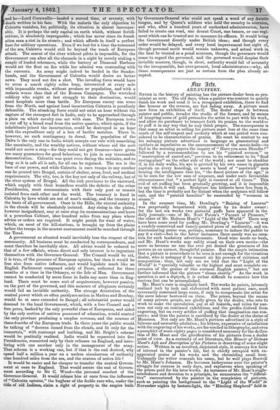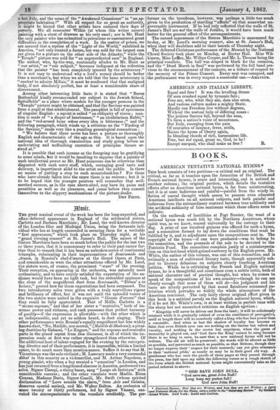fin 2rto.
ART-PUFFERY.
NEVER in the history of painting has the picture-dealer been so pro- minent as now. The old days, when a painter was content to quietly finish his work and send it to a recognized exhibition, there to find due honour or the reverse, are fast fading away. A picture must now form an exhibition of itself. The dealer steps in between painter and public, invades the studio of the former, and by means of tempting sums of gold persuades the artist to part with his work, and allow its purchaser to trumpet forth its praises to the world— to puff it in any way that he may think proper. The consequence is that many an artist in selling his picture must lose at the same time much of the self-respect and modesty which at one period were con- sidered to be characteristics of genius. He must be content to see his unhappy picture advertised in language as grammatical and epithets as superlative as the announcements of the music-halls—to find in the morning papers the inquiry of " Have you seen Blondin?" followed by a recommendation to see his "painted sermon," or " masterpiece of sacred art," previous to its retirement to its " final resting-place" on the other side of the world; nor must he shudder
if, in his daily walks, his eye is greeted by his own name in tie capitals on every hoarding, or meets 'a band of " sandwic " men bearing the intelligence that his, "the finest picture of the age," is to be seen for the low sum of sixpence, and under such favourable circumstances that " a perfect light is ensured at all times." This evil of art puffing has been gradually growing, and it is impossible to say where it will end. Sculpture has hitherto been free from it, but the time is probably not far distant when the sculptors will follow suit, and the "painted homilies" be succeeded by "sermons in stones."
In the summer time, Mr. Dowling's "Raising of Lazarus" was perpetually bespattered withpraise by its dealer owner : for the last six weeks two pictorial puffs have appeared in the daily journals—one of Mr. Noel Paton's "Pursuit of Pleasure," the other of Mr. Holman Hunt's "Light of the World." There may have been some need for puffing Mr. Dowling's "Lazarus"—it was a crudely-conceived and tamely-painted piece of mediocrity, and un- discriminating praise was, perhaps, necessary to induce the public to pay it a visit—but in the latter instances there surely was no occa- sion for such laudatory advertisements. Good wine needs no bush, and Mr. Hunt's works may safely stand on their own merits—the more so because no one has ever yet denied the greatness of his powers as an earnest, thoughtful painter. But the simple intimation that a picture is somewhere to be seen is not enough for the vivacious dealer, who is unhappy if he cannot air his powers of criticism and composition : thus, not only are we told that the "Light of the World" is " specially valuable as the highest and most complete ex- pression of the genius of this eminent English painter," but are further informed that the picture " closes shortly.', As the work in question is not a diptych, it is rather difficult to conceive how this curious feat can be accomplished. Mr. Hunt's case is singularly hard. The works he paints, intensely realized inch by inch and elaborated with most patient care, must necessarily command large sums, if only to compensate the artist for the mere labour bestowed on them. The prices, beyond the means of many private people, are gladly given by the dealer, who sets to work to make the speculation pay at all hazards, and relies for suc- cess not only on continual exhibitions and the profits derived from engravincr, but on every artifice of puffing that imagination can con- ceive; and thus the painter is sacrificed by the dealer at the shrine of Mammon. Not only are Mr. Hunt's pictures advertised in a style of fulsome and unworthy adulation; his letters, expressive of satisfaction with the engraving of his works, are fac-similed in lithography, and even a pamphlet of some eighty pages is considered necessary for the deifica- tion of Mr. Hunt and the glorification of his pictures from a dealer point of view. As a curiosity of art literature, this Memoir of Holman Hunt's Lj[ and Description of his Pictures is deserving of some slight notice. Written in an involved, disjointed style, it conveys few facts of interest in the painter's life, but is chiefly occupied with ex- aggerated praise of his works and the chronicling small beer. Unhappily the writer conceals his name, but he well plays Boswell to Mr. Hunt's Johnson. He becomes lachrymose over the painter's sti-uggle for success in early days, and rapturous when speaking of the prices paid for his later works. As instances of Mr. Hunt's single- mindedness and devotion to a principle, he enumerates the "difficul- ties" encountered by the painter in the completion of pictures, such as painting the background to the "Light of the World" in November nights by lantern-light, the "Hireling Shepherd" field in a hot July, and the scene of the "Awakened Conscience" in "an ap- propriate habitation !" With all respect for so great an authority, it might be hinted that other artists have endured their days of poverty. We all remember Wilkie (at whom this writer sneers) painting with a chest of drawers as his only easel; nor is Mr. Hunt the only painter who has submitted to privations or encountered great difficulties in the completion of a work. In the matter of prices, we are assured that .a replica of the "Light of the World," exhibited in America, "not only created a furore, but was sold for the largest sum yet given for a picture on the other side of the Atlantic," while the "Temple" picture was sold for "an unprecedented sum" in England. The author, who, by-the-way, continually alludes to Mr. Hunt as "our artist," or "our subject," becomes indignant at the reflection that the painter "has been completely ignored by the aristocracy." It is not easy to understand why a lord's money should be better than a merchant's, but when we are told that the same aristocracy is "content to admire Millais," it must be confessed that that maligned body, if not absolutely perfect, has at least a considerable share of discernment.
Among other interesting little facts it is stated that "Baron Rothschild kindly recommended our subject to the Jewish School, Spitalfields" as a place where models for the younger persons in the "Temple" picture might be obtained, and that the Saviour was painted from a pupil at that establishment. The pamphlet is full of specimens of singular English : a squint is called "an obliquity of vision ; men- tion is made of "a diaper of heartseases," "an atrabilarious Rabbi," and the "red-armed briar whose every idea is bitterness ;" and the following paragraph, which winds up a criticism on the " Finding of the Saviour," reads very like a puzzling genealogical conundrum : " We believe that there never has been a picture so thoroughly English and characteristic of the age as this. It is based upon the national idea of thorough examination and study going before an undeviating and unflinching execution of principles thence ar- rived at."
It is possible that such incense as the foregoing may be gratifying to some minds, but it would be insulting to suppose that a painter of such intellectual power as Mr. Hunt possesses can be otherwise than disgusted with such sorry stuff, which, outraging good taste and delicacy, is impertinent alike to the artist and the public. Is there no means of putting a stop to such monntebankism ? For those who have already fallen into the snare there is no redress ; but it is to be hoped that the younger painters will remember that well- merited success, as in the case above-cited, may have its pains and penalities as well as its pleasures, and pause before they commit themselves to the slippery machinations of the picture-dealer.
DST Pont's.



































 Previous page
Previous page